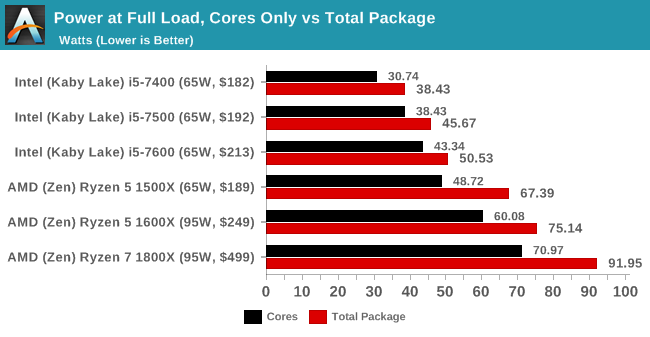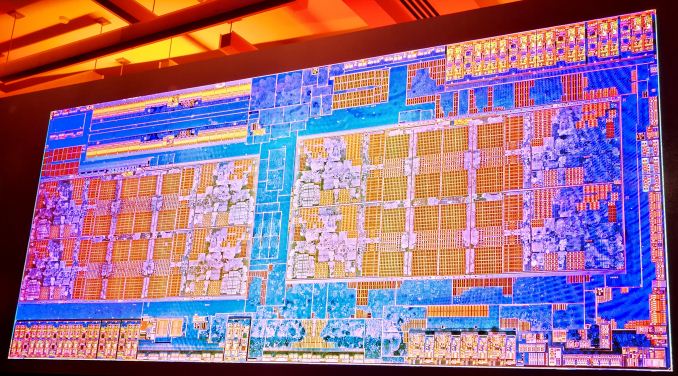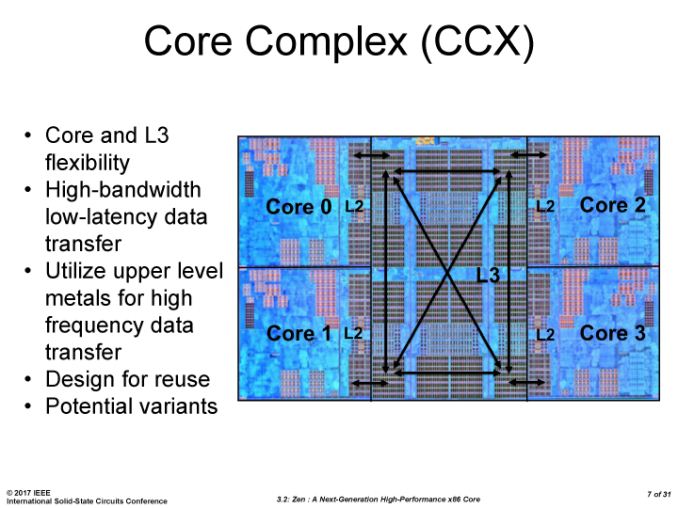The AMD Ryzen 5 1600X vs Core i5 Review: Twelve Threads vs Four at $250
by Ian Cutress on April 11, 2017 9:00 AM ESTRyzen 5, Core Allocation, and Power
In our original review of Ryzen 7, we showed that the underlying silicon design of the Ryzen package consists of a single eight-core Zeppelin die with Zen microarchitecture cores.
The silicon design consists of two core complexes (CCX) of four cores apiece. Each CCX comes with 512 KB of L2 cache per core, which is disabled when a core is disabled, and each CCX has 8MB of L3 cache which can remain enabled even when cores are disabled. This L3 cache is an exclusive victim cache, meaning that it only accepts evicted L2 cache entries, rather than loading data straight into it (which is how Intel builds their current L3 cache designs).
One of the suggestions regarding Ryzen 7’s performance was about thread migration and scheduling on the core design, especially as core-to-core latency varies depending on where the cores are located (and there’s a jump between CCXes). Despite the use of AMD’s new Infinity Fabric, which is ultimately a superset of HyperTransport, there is still a slightly longer delay jumping over that CCX boundary, although the default Windows scheduler knows how to manage that boundary as demonstrated by Allyn at PCPerspective.
So when dealing with a four-core or six-core CPU, and the base core design has eight-cores, how does AMD cut them up? It is possible for AMD to offer a 4+0, 3+1 or 2+2 design for its quad-core parts, or 4+2 and 3+3 variants for its hexacore parts, similar to the way that Intel cuts up its integrated graphics for GT1 variants.
There are some positives and negatives to each configuration, some of which we have managed to view through this review. The main downside from high level to a configuration split across CCXes, such as a 2+2 or 3+3, is that CCX boundary. Given that the Windows scheduler knows how to deal with this means this is less of an issue, but it is still present.
There are a couple of upsides. Firstly is related to binning – if the 2+2 chips didn’t exist, and AMD only supported 4+0 configurations, then if the binning of such processors was down to silicon defects, fewer silicon dies would be able to be used, as one CCX would have to be perfect. Depending on yield this may or may not be an issue to begin with, but having a 2+2 (and AMD states that all 2+2 configs will be performance equivalent) means more silicon available, driving down cost by having more viable CPUs per wafer out of the fabs.
Secondly, there’s the power argument. Logic inside a processor expends energy, and more energy when using a higher voltage/frequency. When placing lots of high-energy logic next to each other, the behavior becomes erratic and the logic has to reduce in voltage/frequency to remain stable. This is why AVX/AVX2 from Intel causes those cores to run at a lower frequency compared to the rest of the core. A similar thing can occur within a CCX: if all four cores of a CCX are loaded (and going by Windows Scheduler that is what happens in order), then the power available to each core has to be reduced to remain stable. Ideally, if there’s no cross communication between threads, you want the computation to be in opposite cores as threads increase. This is not a new concept – some core designs intentionally put in ‘dark silicon’ - silicon of no use apart from providing extra space/area between high power consuming logic. By placing the cores in a 2+2 and 3+3 design for Ryzen 5, this allows the cores to run at a higher power than if they were in 4+0 and 4+2 configurations.
Here’s some power numbers to show this. First, let’s start with a core diagram.
Where exactly the 0/1/2/3 cores are labelled is not really important, except 0-3 are in one CCX and 4-7 are in another CCX. As we load up the cores with two threads each, we can see the power allocation change between them. It is worth noting that the Ryzen cores have a realistic voltage/frequency limit near 4.0-4.1 GHz due to the manufacturing process – getting near or above this frequency requires a lot of voltage, which translates into power.
First up is the 1800X, which is a 4+4 configuration with a maximum TDP of 95W. One fully loaded core gets 22.6W, and represents the core at its maximum frequency with XFR also enabled. The same thing happens with two cores fully loaded, but at 20.6 W apiece. Moving onto three cores loaded is where XFR is disabled, and we see the drop to 3.7 GHz is saving power, as we only consume +1.33W compared to the two cores loaded situation. Three to four cores, still all on the same CCX, shows a decrease in power per core.
As we load up the first core of the second CCX, we see an interesting change. The core on CCX-2 has a bigger power allocation than any core in CCX-1. This can be interpreted in two ways: there is more dark silicon around, leading to a higher potential for this core on CCX-2, or that more power is required given the core is on its own. Technically it is still running at the same frequency as the cores on CCX1. Now as we populate the cores on CCX-2, they still consume more power per core until we hit the situation where all cores are loaded and the system is more or less equal.
Moving to the Ryzen 5 1600X, which is a 3+3 configuration, nets more of the same. During XFR with one or two cores loaded, the power consumption is high. As we move onto the second CCX, the cores on CCX-2 consumer more power per core than those already loaded on CCX-1.
It is worth noting here that the jump from two cores loaded to three cores loaded on the 3+3 gives a drop in the total power consumption of the cores. Checking my raw data numbers, and this also translates to a total package power drop as well, showing how much extra effort it is to run these cores near 4.0 GHz with XFR enabled.
On the Ryzen 5 1500X, using a 2+2 configuration, the situation is again duplicated. The hard comparison here is the 2+2 of the 1500X to the 4+0 on the 1800X, because the TDP of each of the processors is different.
It should be noted however the total package power consumption (cores plus IO plus memory controller and so on) is actually another 10W or so above these numbers per chip.

The cache configurations play an important role in the power consumption numbers as well. In a 3+3 or a 2+2 configuration, despite one or two cores per CCX being disabled, the L3 cache is still fully enabled in these processors. As a result, cutting 25% of the cores doesn’t cut 25% of the total core power, depending on how the L3 cache is being used.
Nonetheless, the Ryzen 5 1600X, despite being at the same rated TDP as the Ryzen 7 1800X, does not get close to matching the power consumption. This ropes back into the point at the top of the page – usually we see fewer cores giving a higher frequency to match the power consumption with parts that have more cores. Because the silicon design has such a high barrier to get over 4.0 GHz with voltage and power, AMD has decided that it is too big a jump to remain stable, but still given the 1600X the higher TDP rating anyway. This may be a nod to the fact that it will cause users to go out and buy bigger cooling solutions, providing sufficient headroom for Turbo modes and XFR, giving better performance.
Despite this, we see the 1800X and 1500X each tear their TDP rating for power consumption (92W vs 95W and 67W vs 65W respectively).
However, enough talking about the power consumption. Time for benchmarks!
















254 Comments
View All Comments
msroadkill612 - Thursday, April 13, 2017 - link
I hear the good ryzen air cooler is pretty good, u sure u wanna bother w/ DIY cooling?Ratman6161 - Tuesday, April 18, 2017 - link
OK, so Friday (4/16) I actually picked up a Ryzen 5 1600 and an Asrock AB350 Pro 4 motherboard so I'm now speaking from some actual experience.So far its fully living up to my expectations. Regular office work its very fast and smooth (but for what I'm doing an i3 would be too). Running three VM's at the same time though, as I hoped, its still fast and smooth even with each VM assigned 4 cores and even when some of the the VM's are actually doing something. So from that alone I think I chose well. CPU was full price $219 but the motherboard was only $39 as part of a bundle deal (Microcenter). Throw in 32 GB RAM for $210 and overall it was a cheap upgrade.
Cooling and Overclocking: I'd disagree (partly) with the included cooler being that good. It does a good job of cooling the CPU but its rather loud compared to what I'm used to. I was using a corsair all in one liquid cooling system (H55 with dual custom fans runing at very low speeds) on the old 2600K so I'm used to a near silent system except when the fans really ramped up during extended stability testing. With the included cooler I've only been able to get it stable at 3.7 Ghz. At 3.8 things get weird. But I'm also not turning up the voltage until I have my liquid cooler back. Ordered the Ryzen bracket for it from Corsair and I'm still waiting on it to come in.
But, whatever Overclock I get is just a bonus. Works great for me at stock speeds.
Memory: I got 16x2 Crucial DDR4 2400 DIMMS which are dual sided. No problem getting them to run at their rated 2400 but no luck at 2666. I was able to tighten up the timings a bit from rated 16-16-16 to 15-15-15 without changing any voltages. I know that's not that fast but for my purposes quantity is what counts most.
I'm not a gamer so I can't say anything about that.
However...I do miss the onboard GPU from my old Intel chip. Why? well, I was running three monitors. My old GTS450 PCIe card only supports two but I used to plug the third (and could have done a 4th) into the processor graphics. So now I'm down to only 2 monitors. Suppose i could buy a newer but cheap video card that supports more than 2?
SkipPerk - Wednesday, May 3, 2017 - link
You can get a ton of cheap card options on ebay that have three video outputs. The AMD ones tend to be cheaper, but there are some nVidia as well. I think I had a 7750 once that was single slot and had three outputs. Tons of the dual slot cards have dual DVI and HDMI. I got a deal on a bunch of GTX 650's a while back that had that config and they supported triple monitor setups beautifully. I might be wrong on that model number now that I think about it. In any case, there are always good, cheap video cards on eBay.MrSpadge - Tuesday, April 11, 2017 - link
Ian, there are lot's of graphs in the gaming section. I think that's rather hard to read. You could combine the average FPS and 99th percentile into the same graph. Not sure how to make it look pretty, but since both graphs mostly carry the same mesage that would make it obviously more compact.Icehawk - Tuesday, April 11, 2017 - link
They are way too dense, I skipped all of the gaming pages... and I'm a gamer.milkod2001 - Tuesday, April 11, 2017 - link
Will you be updating results to BENCH? . I'd like to see how 1600x, 1700x and 1800x stack vs my existing Haswell 4770Kzodiacfml - Tuesday, April 11, 2017 - link
Praise you for the RX480 benches there! Finally! Being GPU limited, the advantage of Intel chips are small. Many users might not be able to take advantage of the extra cores but in a few years, it will have its value.th3ron - Tuesday, April 11, 2017 - link
People posted the samething when the 8150 was launched and we know how that turned out.SkipPerk - Wednesday, May 3, 2017 - link
The 8150 was not bad once the price came down. I bought one for $160 years ago, and I still use it on a secondary machine. It is a nice little chip for the money. My only regret is that I ran it at 4.8 ghz for years, and now i need to run it at 3.6 or lower or it gets strange. It was a fine chip compared to the i5 2500.10101010101010 - Tuesday, April 11, 2017 - link
Why not overclock the K? The whole battle is core speed Vs core number so it couldn't be more disingenuous to completely strip the main reason for buying the Intel chip away.